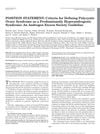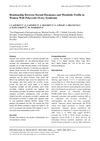TLDR Certain metabolites may help diagnose and predict polycystic ovary syndrome.
This study investigated the serum metabolic profiles of 31 women with polycystic ovary syndrome (PCOS) compared to 31 healthy controls using a metabolomics approach with UPLC-HRMS technology. The analysis identified 68 downregulated and 78 upregulated metabolites in PCOS patients, primarily involving triacylglycerols, glycerophosphocholines, acylcarnitines, and other compounds. These metabolites were enriched in pathways such as glycerophospholipid metabolism and fatty acid degradation. The study highlighted specific metabolites with high diagnostic value, suggesting their potential as metabolic markers for PCOS prognosis and diagnosis.
 30 citations
,
January 2016 in “Journal of Pharmaceutical and Biomedical Analysis”
30 citations
,
January 2016 in “Journal of Pharmaceutical and Biomedical Analysis” The research found different metabolism changes in PCOS patients and suggested new potential markers for diagnosing PCOS with or without insulin resistance.
 71 citations
,
January 2014 in “Journal of Proteome Research”
71 citations
,
January 2014 in “Journal of Proteome Research” Women with PCOS have different levels of certain fats and proteins in their blood, which could help diagnose the condition.
 1744 citations
,
August 2006 in “The Journal of Clinical Endocrinology and Metabolism”
1744 citations
,
August 2006 in “The Journal of Clinical Endocrinology and Metabolism” Polycystic Ovary Syndrome should be seen mainly as a condition of excess male hormones, with a focus on this in its definition.
 4809 citations
,
January 2004 in “Fertility and Sterility”
4809 citations
,
January 2004 in “Fertility and Sterility” The 2003 consensus updated PCOS diagnosis criteria and highlighted increased risks of diabetes and heart disease for those affected.
 4025 citations
,
December 2003 in “Human Reproduction”
4025 citations
,
December 2003 in “Human Reproduction” The 2003 consensus updated PCOS diagnosis criteria and linked PCOS to higher risks of diabetes and heart problems, recommending lifestyle changes to lower these risks.
 January 2021 in “Research Square (Research Square)”
January 2021 in “Research Square (Research Square)” Women with PCOS have different levels of certain metabolites in their blood, which could help diagnose and predict the condition.
45 citations
,
May 2022 in “Biomedicines” Analyzing follicular fluid can help predict and improve outcomes for women with PCOS undergoing fertility treatments.
 13 citations
,
March 2019 in “Physiological Research”
13 citations
,
March 2019 in “Physiological Research” Overweight women with PCOS have higher levels of certain hormones that could indicate a higher risk of heart and metabolic problems.
 138 citations
,
July 2015 in “Clinical, Cosmetic and Investigational Dermatology”
138 citations
,
July 2015 in “Clinical, Cosmetic and Investigational Dermatology” Eating less sugar, milk, and saturated fats and more vegetables and fish may help treat and prevent acne.
54 citations
,
May 2015 in “Endocrinology” Manipulating 5α-reductase type 2 can affect liver fat production and glucocorticoid effects.







